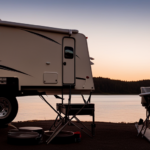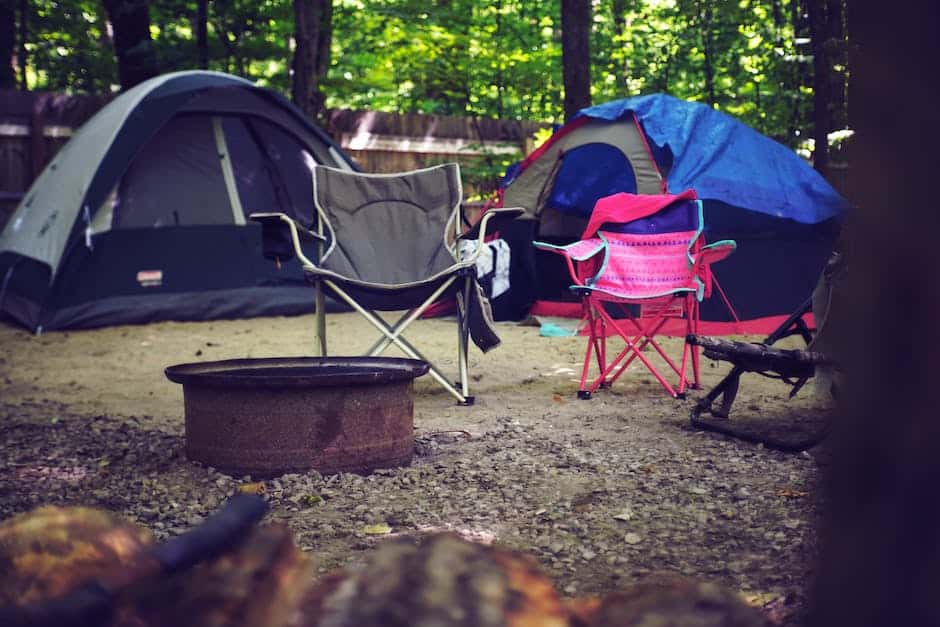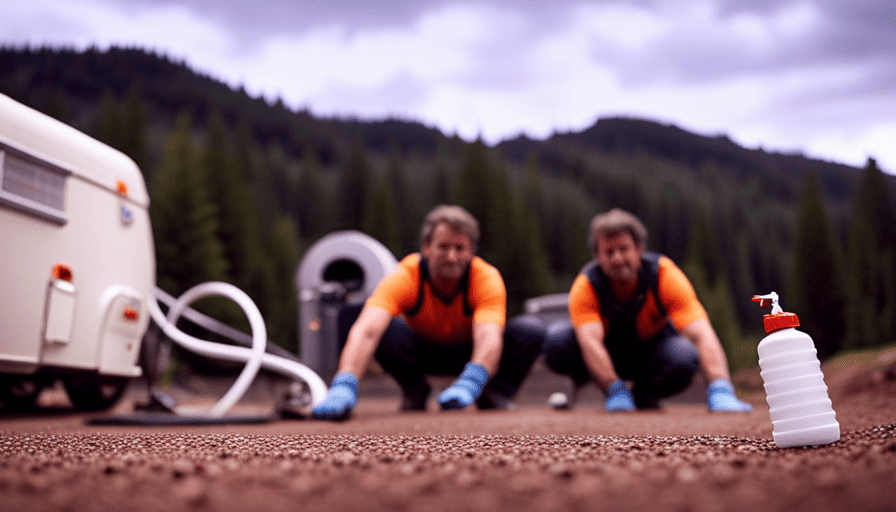Envision setting off on an exciting adventure in your truck camper, eager to discover new vistas and forge lasting memories. But wait! Before you venture out, making sure your truck camper is firmly anchored is essential. Safety should be your top priority when traveling with such a hefty burden.
In this article, we will guide you through the process of tying down your truck camper, step-by-step. From assessing your truck’s tie-down points to securing loose items inside the camper, we will cover all the essential tips and techniques to ensure a safe and smooth journey.
By following our detailed instructions and using the right equipment, you can have peace of mind knowing that your truck camper is securely fastened. So, let’s dive in and discover the secrets to tying down your truck camper effectively. First and foremost, it’s important to properly attach the tie-downs to the designated anchor points on your truck. Then, adjusting the tension to ensure a snug fit and preventing sliding in your camper. This will ensure a safe and worry-free traveling experience, allowing you to focus on enjoying the journey ahead.
Get ready for an adventure like no other!
Key Takeaways
- Assess your truck’s tie-down points and gather the necessary equipment for securing the truck camper.
- Attach ratchet straps evenly to anchor points on the truck and camper, and use turnbuckles for added stability.
- Position the truck camper in the center of the truck bed and ensure it is snugly fitted to prevent shifting.
- Regularly inspect and maintain the tie-down system for safety, including checking tie-down straps for wear and tear, inspecting anchor points for secure fastening, and using a level to ensure proper weight distribution.
Assess Your Truck’s Tie-Down Points
Now, let’s take a closer look at your truck and see where you can find those essential tie-down points for truck camper installation. Securing your truck camper properly is crucial for a safe and stable journey.
The good news is that most trucks come with designated tie-down points that are specifically designed to handle the weight and movement of a camper. Start by examining the bed of your truck. Look for metal loops or hooks attached to the bed frame. These are usually located near the corners of the truck bed and are commonly used for securing cargo. These tie-down points can be used to anchor your camper and prevent it from shifting during transit.
Additionally, check if your truck has stake pockets on the sides. These are small openings along the bed rail that allow you to insert tie-down anchors. They provide another option for securing your truck camper.
Remember to inspect the tie-down points thoroughly to ensure they’re in good condition and securely fastened to the truck. If any of the tie-down points are damaged or loose, it’s essential to repair or replace them before proceeding with the installation.
Now that you’ve identified the tie-down points on your truck, the next step is to gather the necessary equipment for securing your truck camper.
Gather the Necessary Equipment
In order to properly secure a truck camper, it’s important to gather the necessary equipment. We recommend using ratchet straps, turnbuckles, and anchor points.
Ratchet straps are essential for tightening and securing the camper to the truck bed, while turnbuckles provide added stability and prevent any movement during transportation. Additionally, anchor points are crucial for attaching the straps and turnbuckles to the truck’s tie-down points, ensuring a strong and secure connection.
Ratchet Straps
First, make sure you have a sturdy set of ratchet straps ready to secure your truck camper in place. When choosing the right ratchet straps, opt for heavy-duty ones with a high weight capacity to ensure maximum security. Look for straps that are at least 1 inch wide and have a reliable ratchet mechanism for easy tightening.
It’s crucial to properly secure the truck camper, especially for off-road adventures. Start by attaching the ratchet straps to the anchor points on your truck and camper, making sure they are evenly distributed. Tighten the straps gradually, checking for any slack or movement. This will keep your camper securely fastened, minimizing any potential shifting during travel.
Now, let’s move on to the next section and discuss the importance of turnbuckles in securing your truck camper.
Turnbuckles
To ensure maximum security, it’s important to use turnbuckles in addition to ratchet straps when securing your truck camper. Turnbuckles provide an extra level of stability and prevent any movement during transit. When installing your truck camper, follow these guidelines for proper turnbuckle usage:
- Choose high-quality turnbuckles that are specifically designed for truck camper applications.
- Attach the turnbuckles to the anchor points on the camper and the truck bed, ensuring a tight fit.
- Adjust the turnbuckles to remove any slack and create a secure connection between the camper and the truck.
By incorporating turnbuckles into your tie-down system, you can significantly enhance the safety and stability of your truck camper.
Once you have properly secured the camper using turnbuckles, you can proceed to the next step of anchoring the camper to the truck bed for added security.
Anchor Points
Make sure you locate the anchor points on your vehicle and camper to ensure a secure and stable connection.
Truck camper safety is of utmost importance, and properly securing your camper to your truck is crucial to prevent any accidents or damage while on the road. Anchor points serve as attachment points between your truck and camper, providing stability and preventing any movement or shifting during transportation.
When choosing anchor points, look for sturdy points on both your truck and camper that are capable of handling the weight and stress of the camper. It’s recommended to use a combination of straps and turnbuckles to secure the camper tightly to the truck. By doing so, you can have peace of mind knowing that your camper is securely attached to your truck, ensuring a safe and smooth journey.
With your anchor points secured, let’s move on to the next step of positioning your truck camper.
Position Your Truck Camper
Once you’ve chosen the perfect spot, carefully align your truck camper with the bed of your truck, ensuring it’s centered and snugly fitted. This is an important step in truck camper leveling and securing the camper to prevent shifting during travel.
To position your truck camper effectively, follow these steps:
-
Adjust the position of your truck so the camper is evenly balanced on all sides. This’ll help maintain stability during your journey.
-
Make sure the truck camper is aligned with the centerline of your truck bed. This’ll ensure weight distribution is even and prevent any unnecessary strain on the truck’s suspension system.
-
Check that the camper is snugly fitted against the truck bed. This’ll prevent any movement or shifting while on the road.
Once your truck camper is properly positioned, you can move on to the next step of the tie-down process. Attach the ratchet straps to secure the camper firmly in place. Next, make sure the ratchet straps are tightened securely to prevent any movement while driving. It’s important to double-check all connections and straps to ensure the camper is safe and secure. For added stability, consider installing a stabilizer bar. Stabilizer bar installation tips can be found in the camper’s manual or by consulting with a professional. This will help to minimize sway and maintain the balance of the camper during travel.
Attach the Ratchet Straps
In order to ensure the stability of your truck camper during travel, it’s crucial to attach the ratchet straps securely. Proper tensioning techniques and choosing the right ratchet straps are essential for a safe and secure journey.
When attaching the ratchet straps, start by placing them diagonally across the truck camper. This will create an X shape, providing optimal stability. Make sure the straps aren’t twisted and that the hooks are securely attached to the camper’s tie-down points.
To properly tension the straps, use the ratchet mechanism. Insert the strap into the ratchet and pull it tight. Then, crank the ratchet handle to tighten the strap even further. This’ll ensure that the truck camper is securely fastened to the truck bed.
When choosing the right ratchet straps, make sure they’re rated for the weight of your truck camper. Look for straps that have a high working load limit and are made of durable materials.
Once the ratchet straps are securely attached, you can further enhance the stability of your truck camper by using turnbuckles. These devices can be attached to the camper’s tie-down points and the truck bed, providing additional support and reducing any potential movement.
By following these proper tensioning techniques and choosing the right ratchet straps, you can ensure that your truck camper is securely attached and ready for a smooth and stable journey. Now, let’s move on to using turnbuckles for additional stability.
Use Turnbuckles for Additional Stability
For an even smoother and more secure journey, take your stability to the next level by utilizing turnbuckles. These handy devices are an excellent addition to your truck camper tie-down system, providing added security and peace of mind.
Using turnbuckles for added security is a straightforward process that can greatly enhance the stability of your camper.
To ensure proper installation of turnbuckles, start by attaching one end to a secure anchor point on your truck. This can be a frame-mounted bracket or an attachment point specifically designed for turnbuckles.
Next, connect the other end of the turnbuckle to a designated anchor point on your camper. This can be a bracket or ring located on the camper’s frame.
Once both ends are securely attached, use the turnbuckle’s adjusting mechanism to tighten the connection. This will help eliminate any unwanted movement or sway while traveling. It’s important to ensure that the turnbuckles are tightened evenly and securely to provide maximum stability.
With your turnbuckles properly installed, you can now double-check the tightness of your tie-downs. By doing so, you can ensure that everything is secure and ready for your next adventure.
Double-Check the Tightness of Your Tie-Downs
After securing your truck camper with turnbuckles for additional stability, it’s crucial to double-check the tightness of your tie-downs. This step is crucial to ensure that your camper stays securely attached to your truck during travel.
To properly check the tightness of your tie-downs, start by visually inspecting each individual tie-down strap. Look for any signs of wear or damage, such as frayed edges or tears. If you notice any issues, it’s essential to replace the strap before hitting the road.
Next, physically test the tension of each tie-down strap. Apply gentle pressure to each strap, ensuring that it’s snug and secure. You shouldn’t be able to move the camper or truck by pushing or pulling on the tie-down straps. If you find any slack, readjust and tighten the straps until they’re firm.
Remember, a properly secured truck camper is essential for safe and stable travel. Neglecting to double-check the tightness of your tie-downs could lead to dangerous situations on the road.
With your tie-downs securely tightened, it’s time to move on to the next step: testing the stability of your camper.
Test the Stability of Your Camper
Now, take a moment to ensure your camper is stable by testing its balance and security. Camper stability is crucial for a safe and comfortable journey. Here are some testing methods to help you achieve that peace of mind:
-
Rock and Roll: Gently push and pull on the camper from different angles to check for any excessive movement. If it rocks or sways, it may indicate loose tie-downs or an unbalanced load.
-
Shake It Up: Give the camper a good shake to see if anything rattles or shifts inside. This’ll help you identify any loose items that need to be secured.
-
Weight Distribution: Step inside the camper and walk around to evaluate how it feels. If it feels unstable or uneven, you may need to adjust the weight distribution of your belongings.
-
Tire Check: Inspect the tires for signs of wear or damage. Proper tire maintenance is essential for stability on the road.
-
Wind Test: If possible, park your camper in an open area and observe how it handles in windy conditions. Excessive swaying or instability could indicate a need for adjustments.
By ensuring the stability of your camper, you’ll have a safer and more enjoyable journey. Now, let’s move on to securing loose items inside the camper.
Secure Loose Items Inside the Camper
To ensure a safe and comfortable journey, it’s important to securely fasten any loose items inside your camper. Not only will this prevent damage to your belongings, but it will also help maintain stability while on the road. Before hitting the highway, take the time to secure all loose items inside your camper.
Start by evaluating the storage compartments in your camper. Make sure they’re sturdy and in good condition. If necessary, add additional straps or bungee cords to keep items in place. Consider using storage containers or bins with secure lids to prevent items from shifting during travel.
Next, secure larger items such as chairs, tables, and appliances. Use ratchet straps or bungee cords to anchor them to the walls or floor of the camper. Wrap fragile items like dishes and glassware in bubble wrap or towels and place them in secure cabinets or drawers.
Lastly, don’t forget about the smaller items. Use ziplock bags or small containers to group similar items together and prevent them from rolling around. Secure these bags or containers in cabinets or drawers.
By taking the time to secure loose items inside your camper, you can prevent damage and ensure a smoother journey. Regularly inspect and maintain your tie-down system to make sure everything remains secure during your travels.
Regularly Inspect and Maintain Your Tie-Down System
Regularly checking and maintaining your tie-down system is essential for a safe and comfortable journey in your camper. By performing regular maintenance on your tie-down system, you can ensure that it remains in good working condition and reduces the potential risks of accidents or damage to your camper.
Start by inspecting the tie-down straps for any signs of wear and tear. Look for fraying, cuts, or any other damage that may compromise their strength. Replace any damaged straps immediately to maintain the integrity of your tie-down system.
Additionally, check the tension of the straps to ensure they’re properly securing the camper to the truck bed.
Inspect the anchor points on your truck bed as well. Make sure they’re securely fastened and free from any rust or corrosion that could weaken their hold. If necessary, clean and lubricate the anchor points to prevent rust and ensure smooth operation.
Regularly inspecting and maintaining your tie-down system will give you peace of mind, knowing that your camper is securely fastened to your truck. It’ll also help prevent any potential risks during your journey.
In the next section, we’ll provide additional tips for a safe and smooth journey with your truck camper.
Additional Tips for a Safe and Smooth Journey
As you embark on your adventure with your trusty mobile companion, keep in mind these additional tips to ensure a safe and smooth journey.
When it comes to leveling your truck camper, there are a few tips that can make a big difference. First, always use a level to ensure that your camper is sitting evenly on the truck bed. This will not only provide stability but also prevent any unnecessary strain on your tie-down system.
Additionally, make sure to adjust the jacks on your camper to achieve a level position. This will not only make for a more comfortable experience inside but also help with weight distribution on the truck.
When tying down your truck camper, it’s important to avoid some common mistakes. One common mistake is not tightening the tie-downs enough. Always double-check that the tie-downs are securely fastened and tightened to the appropriate tension.
Another mistake to avoid is over-tightening the tie-downs, as this can lead to damage or even breakage. It’s important to find the right balance of tightness to ensure a secure hold without putting too much strain on the camper or the tie-down system.
By following these tips for leveling a truck camper and avoiding common tying down mistakes, you can enjoy a safe and smooth journey with your trusty mobile companion.
Frequently Asked Questions
How do I know if my truck’s tie-down points are strong enough to secure a camper?
To determine if your truck’s tie-down points are strong enough to secure a camper, you need to consider the weight of the truck camper and explore different tie-down options.
Start by checking your truck’s owner’s manual for the recommended maximum payload capacity and the specific tie-down points. You can also consult with the camper manufacturer or a professional installer for guidance on suitable tie-down systems.
It’s crucial to ensure that the tie-down points are robust enough to handle the weight and securely hold the camper in place during travel.
What kind of equipment do I need to tie down a truck camper?
To properly secure a truck camper and prevent shifting during travel, you’ll need a few key pieces of equipment. First, make sure you have sturdy ratchet straps or tie-downs that can withstand the weight and movement of the camper.
When it comes to knots, use reliable options like the trucker’s hitch or the bowline knot. These knots provide a secure hold while allowing for easy adjustment.
Remember to tighten the straps evenly on all sides for optimal stability.
Can I position my truck camper in any way, or are there specific guidelines to follow?
When securing a truck camper, it’s important to follow specific guidelines to ensure it’s positioned correctly. There are different methods for securing a truck camper, such as using turnbuckles, tensioning devices, and anchor points.
It’s crucial to avoid common mistakes, such as over-tightening the tie-downs or not properly aligning the camper with the truck bed. By following these guidelines and using the appropriate equipment, you can safely and securely position your truck camper.
Are ratchet straps the only type of straps I can use to secure the camper?
There are various types of straps available for securing a truck camper, not just ratchet straps. While ratchet straps are popular due to their ease of use and adjustable tension, other options include cam buckle straps, rope, or even bungee cords.
Each type has its pros and cons. Ratchet straps provide a secure and tight hold, but they may require more effort to tighten. It’s important to consider the specific needs of your camper and choose the type of strap that best suits your requirements.
How often should I inspect and maintain my tie-down system for optimal safety?
Inspection frequency and proper maintenance are crucial for ensuring optimal safety of your tie-down system. Regular inspections should be conducted to identify any signs of wear, damage, or loose connections. It’s recommended to inspect the tie-down system before every trip and periodically during use.
Maintenance includes tightening any loose straps or bolts, lubricating moving parts, and replacing worn-out components. By prioritizing inspection and maintenance, you can ensure a secure and safe tie-down system for your truck camper.
What Are the Best Techniques for Tying Down a Truck Camper?
When looking to install truck camper tie downs, it’s important to use the best techniques for securing your camper. Start by choosing high-quality tie downs that are specifically designed for your truck model. Then, carefully follow the manufacturer’s instructions to ensure a safe and secure installation.
Conclusion
Well, folks, we’ve reached the end of our truck camper tying adventure. We’ve learned all about assessing tie-down points, gathering the necessary equipment, and positioning our trusty campers.
With ratchet straps and turnbuckles in hand, we’ve secured our homes on wheels with the strength of a thousand Hercules. And let’s not forget the importance of testing stability and securing loose items inside the camper.
So, grab your checklist and regularly inspect and maintain your tie-down system for a safe and smooth journey. Happy camping, fellow adventurers!



















